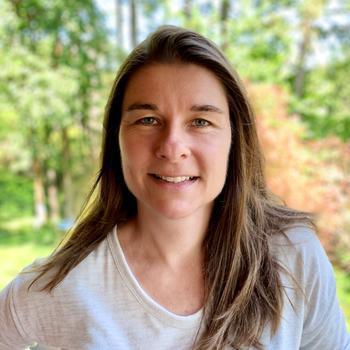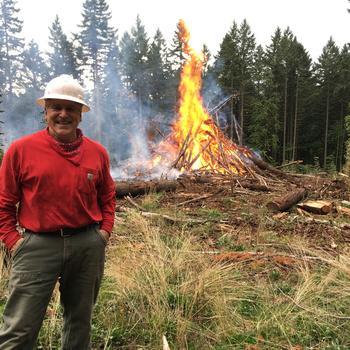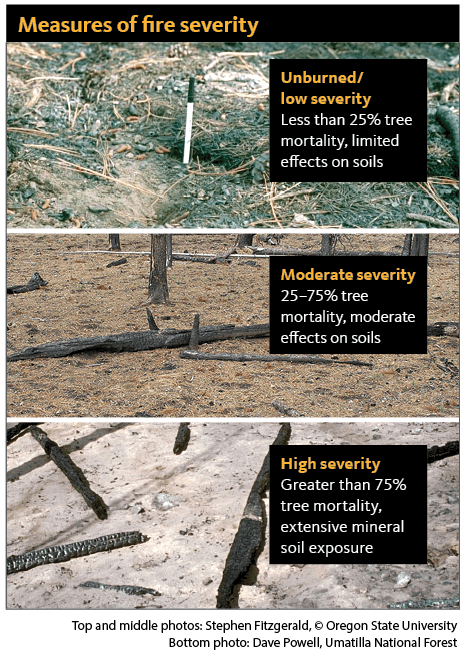Fire severity is a quantitative measure of the effects of a fire on the environment, typically considering both the damage to vegetation and the impacts on the soil. Fire severity is described along a spectrum, ranging from unburned/low severity, to moderate severity, and high severity.
Fire severity is driven by multiple factors that affect how a fire behaves. Those factors are often depicted in what’s called a “fire behavior triangle.” The three major factors in the triangle are:
- The weather conditions during the fire (wind, temperature, humidity)
- The topography of the landscape (slope, aspect)
- The amount, arrangement, and types of fuels that are present during the fire
When fires burn during extreme weather conditions, weather almost always overrides the other local factors when fuels are present. Weather that can lead to rapid fire growth and extreme conditions occurs when wind speeds are greater than 20 miles per hour at slightly above ground level, temperatures are at 80ºF or greater, and relative humidity is less than 20 percent. Weather conditions on a fire can change daily or even within the day.
Fire severity is also influenced by topography. Fires tend to be more severe on mid- and upper-slope positions than on lower slopes because wind speeds and convection winds are often greater on the upper slopes due to drainages, canyons, and saddles that channel upslope winds. In most cases, south- and west-facing slopes burn more severely than north-facing slopes because these aspects get more sun for longer periods. Natural barriers such as rock outcroppings and waterways can help to slow the spread of a fire and decrease the severity.
The amount, arrangement, type of fuels (including live and dead vegetation), and the duration of the burn are important factors that determine how a given fire will respond to the landscape and to the degree of fire severity. For example, high-severity burned areas are generally associated with two types of forests: dense, multi-layered forests with “ladders” of flammable materials that allow a ground fire to ignite the canopy; and uniform, young, even-aged forests.
Factors such as warmer and drier climate conditions, past management practices (removal of fire-resistant trees and excess fuels left on the site), an increase in human-caused fires, and fire suppression (which allows the amount of fuel to increase) have contributed to an overall increase in fire severity in recent years. For example, areas of central, eastern, and southwestern Oregon, where fires have historically burned frequently at low and moderate severities, are now experiencing a greater proportion of high-severity fires.
There are risks, costs, and benefits associated with any type of fire severity, and a fire’s severity can have differential effects on various resources simultaneously. A high-severity fire in a watershed can have negative effects on water quality due to runoff and sedimentation, or on aquatic species due to increased water temperatures from overstory vegetation damage or death. However, high-severity fires don’t always lead to negative impacts on resources of value. They can also provide habitat for some species and enhance early seral biodiversity. In fact, many species of birds, mammals, insects, and plants depend on high-severity fire to meet their ecological requirements. The black-backed woodpecker is one good example. This bird uses patches of dead trees for nesting and foraging.
While we can’t manipulate weather or topography to affect fire severity, we can manipulate fuels. Land managers use treatments such as thinning and prescribed fire, where appropriate, to prevent excessive fuel buildup. These efforts can help minimize the impact of a fire on the vegetation and soil. However, such measures must be deployed over large areas in order to affect a fire’s behavior and severity.
Resources
Cansler, C.A., and D. McKenzie. 2014. Climate, fire size, and biophysical setting control fire severity and spatial pattern in the northern Cascade Range, USA. Ecological Applications, 24(5): 1037-1056.
Bond, M.L., R.B. Siegel, R.L. Hutto, V.A. Saab, and S.A. Shunk. 2012. A New Forest Fire Paradigm: The need for high-severity fires. The Wildlife Professional, Pp. 46-49.
Estes, B.L., E.E. Knapp, C.N. Skinner, J.D. Miller, and H.K. Preisler. 2017. Factors influencing fire severity under moderate burning conditions in the Klamath Mountains, northern California, USA. Ecosphere, 8(5): e01794.
Keeley, J.E. 2009. Fire intensity, fire severity and burn severity: a brief review and suggested usage. International Journal of Wildland Fire, 18: 116-126.
Leavell, D., C. Berger, S. Fitzgerald, and B. Parker. 2017. Fire Science Core Curriculum, modules 2 and 3, Extension Experiment Station Communications, EM 9172.
Lyons-Tinsley, C., and D.L. Peterson. 2012. Surface fuel treatments in young, regenerating stands affect wildfire severity in a mixed conifer forest, eastside Cascade Range, Washington, USA. Forest Ecology and Management, 270: 117-125.
Northwest Fire Science Consortium. Fire Fact: What is? Fire Behavior. Accessed September 18, 2018.
Northwest Fire Science Consortium. Fire Fact: What is? Fuel. Accessed September 18, 2018.
Northwest Fire Science Consortium. Fire Fact: What is? Fire Severity. Accessed March 6, 2018.
Northwest Fire Science Consortium. Fire Fact: What is? Topography. Accessed September 18, 2018.
Northwest Fire Science Consortium. Fire Fact: What is? Weather. Accessed September 18, 2018.
Prichard, S.J., and M.C. Kennedy. 2014. Fuel treatments and landform modify landscape patterns of burn severity in an extreme fire event. Ecological Applications, 24(3): 571-590.
Reilly, M.J., C.J. Dunn, G.W. Meigs, T.A. Spies, R.E. Kennedy, J.D. Bailey, and K. Briggs. 2017. Contemporary patterns of fire extent and severity in forests of the Pacific Northwest, USA (1985–2010). Ecosphere, 8(3): e01695.
Zald, H.S., and C.J. Dunn. 2018. Severe fire weather and intensive forest management increase fire severity in a multi-ownership landscape. Ecological Applications, 28(4): 1068-1080.
© 2018 Oregon State University.
Extension work is a cooperative program of Oregon State University, the U.S. Department of Agriculture, and Oregon counties. Oregon State University Extension Service offers educational programs, activities, and materials without discrimination on the basis of race, color, national origin, religion, sex, gender identity (including gender expression), sexual orientation, disability, age, marital status, familial/parental status, income derived from a public assistance program, political beliefs, genetic information, veteran’s status, reprisal or retaliation for prior civil rights activity. (Not all prohibited bases apply to all programs.) Oregon State University Extension Service is an AA/EOE/Veterans/Disabled.




